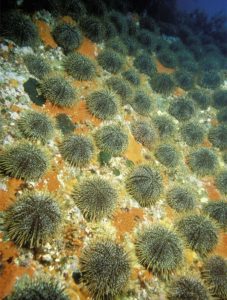

A community of grazing echinoderms have almost cleaned the bedrock surface of bryozoa and algae (depth 25 m). In the process they add fine bioclastic debris to the local sediment mass. Three Kings Islands, northernmost NZ. Image courtesy of Cam Nelson.
Echinoderms and barnacles are important contributors to bioclastic limestones
Echinoids are a diverse phylum with a geological history dating back to Early Cambrian. This entirely marine group of invertebrates includes the familiar Crinoids, star fish (Stelleroids and Ophiuroids), sea urchins (Echinoids) and sea cucumbers (Holothuroids), all of which have modern representatives. There are also several extinct groups. Most groups have five-fold skeletal division.
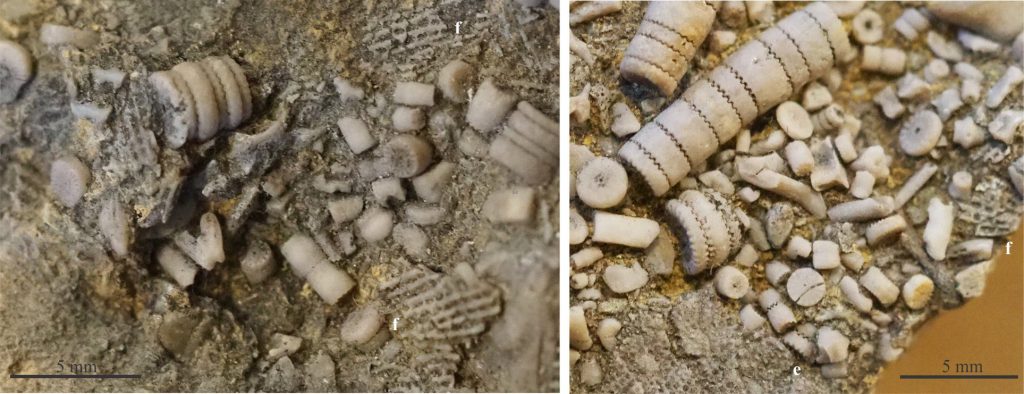

Devonian crinoid stems and disarticulated columnals in the bioclastic mix with fragmented fenestrate (f) and encrusting bryozoans (e).
Barnacles are arthropods, a phylum that includes spiders, scorpions, Horseshoe Crabs, and crustaceans like crabs, shrimp and lobster. They are included in this phylum because they have up to 6 appendages that, instead of being attached to a thorax and used as legs, are delicate, feathery wands that are extended and retracted in search of food. They are fully marine and as adults are firmly attached to rocky, or shelly substrates. The oldest definitive barnacles are Carboniferous, but it wasn’t until the Late Cretaceous that species diversity increased, becoming important contributors to Cenozoic cool-temperate limestones.
Although clearly disparate groups of invertebrates, echinoderms and barnacles do have a few attributes in common:
– Both are important contributors of bioclasts to cool-temperate carbonate sediments. They also play important roles in tropical reef systems, but the volume of sediment they produce is proportionally less.
– They shed calcium carbonate plates to the sediment mass; echinoderms also shed spines.
– They are bioeroders; barnacles erode or corrode the substrate (bedrock, other shelly organisms) prior to growing their basal plate, and echinoderms produce fine-grained bioclastic material while munching coral, bryozoa and calcareous algae.
– They are marine organisms that thrive in shallow environments washed by waves and currents, although some species occur at bathyal depths (e.g., some brittle stars; and barnacles like Bathylasma). They coexist with many other invertebrates and reef-builders.
Echinoderms
All common echinoderms (except the sea slugs) have segmented exoskeletons. Each segment, or plate is a single crystal of calcite; each attached spine is also a single calcite crystal. Calcite in modern echinoids is high in magnesium; the Mg is replaced by Ca during recrystallization to low magnesium calcite. When the animal dies, the exoskeleton breaks up into its constituent plates and spines.
Echinoderms bioclasts, even as small fragments, are relatively distinctive in thin section:
- In life, the plates and spines are porous. In thin section this appears as uniformly distributed, microscopic perforations. The pores are filled with calcite cement during burial diagenesis; they may also be filled by glauconite.
- In transverse sections, spines show a distinctive radial crosshatch pattern formed by the intersection of concentric growth rings and perforations arranged in radial fashion.
- Plates and spines consist of a single calcite crystal that will show uniform extinction under crossed polars (unless the fragments have been strained during deformation).
- Calcite cement overgrowths are usually syntaxial, such that both plate and spine plus cement will go into extinction simultaneously (they share the same crystallographic axes).
- Crystallographic c axes parallel the long axes of spines.
- The magnesium content of skeletal calcites is variable, even within a single specimen. For example, spines commonly vary from 5-10% MgCO3, and plates up to 16%. Much of the Mg is replaced during diagenesis so that spines and plates plus their syntaxial cement overgrowths are low magnesium calcites (inclusions of HMC may be retained within the crystals).
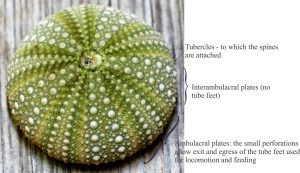

Recent echinoderm, minus its spines that detached soon after the animal died. The spines were attached to the primary tubercles. The 5-fold symmetry is readily apparent. The five ambulacral and interambulacral areas each consist of interlocking calcite plates that tend to separate when the animal dies. Image credit Sheila Brown.


An abraded echinoderm plate in modern beachrock, Hawaii. The perforated structure is easily identified. Under crossed polars the grain extinguishes as a single crystal. Plain polarized light.
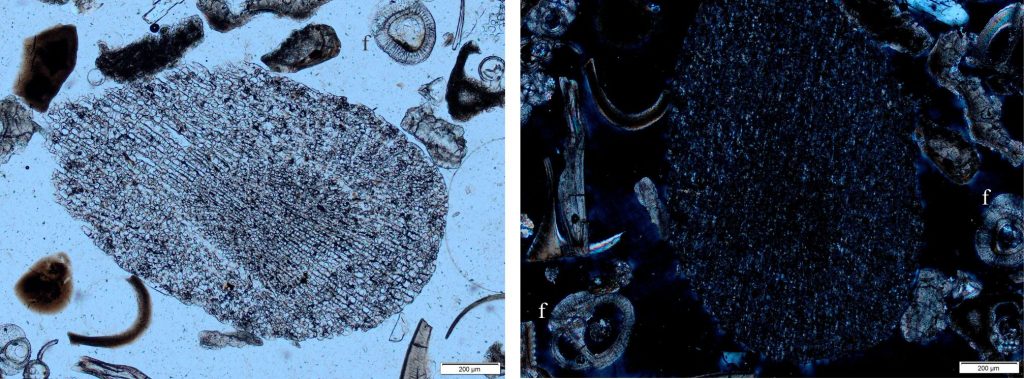

Recent echinoderm plate, slightly rounded by abrasion, sampled from temperate water bioclastic sand (that includes benthic forams (f), bryozoa, barnacle, and mollusc fragments). The perforations are unfilled. Left: Plain polarized light; Right: crossed polars with the grain in full extinction. Grain mount thin section. Three Kings Islands, northernmost NZ.
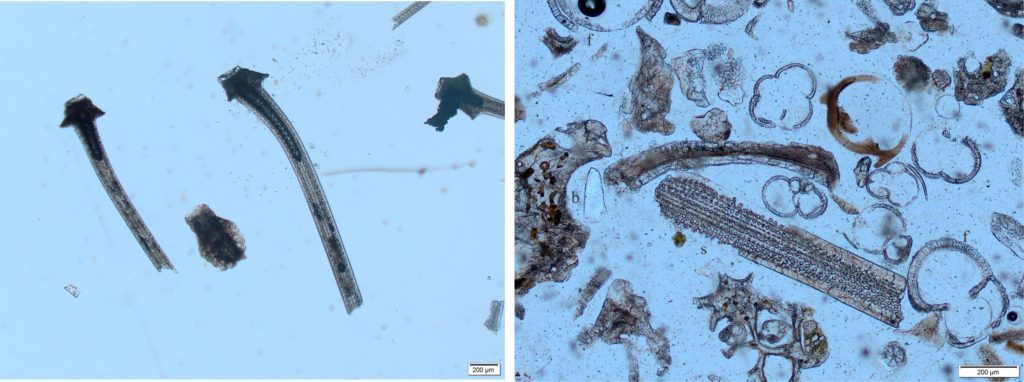

Grain mount thin sections of bioclastic sand sampled from about 30 m water depth, Three Kings Islands, northernmost NZ. Left: Small echinoderm spines with the basal tubercle attachment intact. Right: Longitudinal section of a broken and partly abraded echinoderm spine (s) showing the characteristic arrangement of perforations parallel to the spine long axis. Specimen occurs with unfilled foram tests (f) and abraded barnacle fragments (b). Both images plain polarized light.
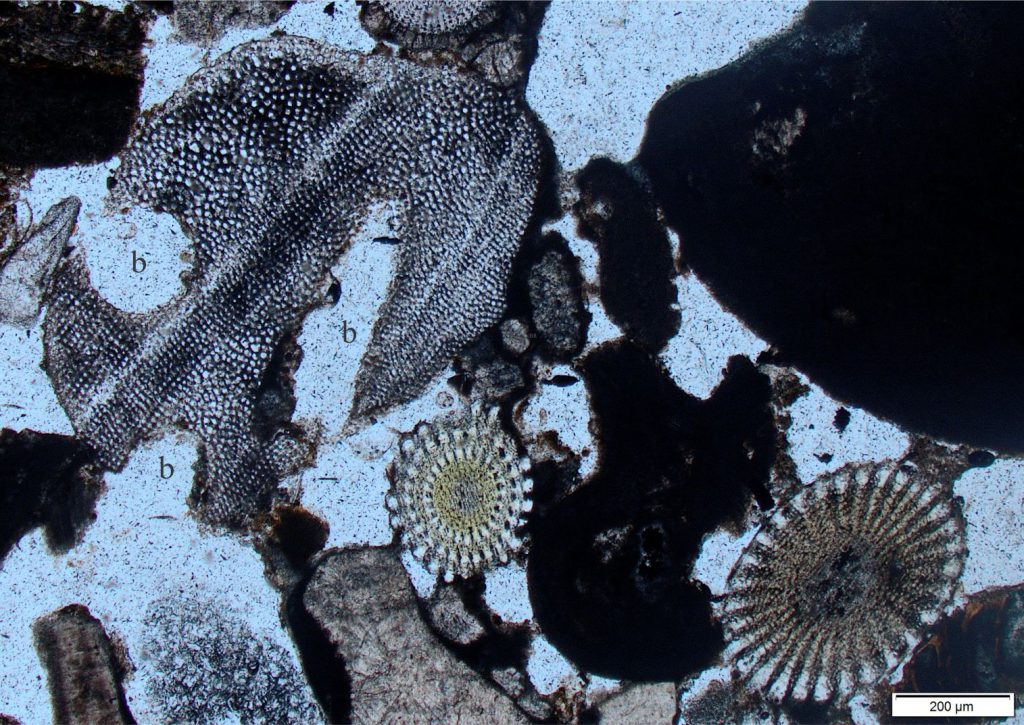

Bioclastic beachrock (Hawaii) showing an abraded and bored echinoderm plate (top left). The margins of the plate and the borings (b) are lined with a thin rind of pale brown micrite. Two transverse sections of echinoderm spines (lower center and right) display typical radial fenestrate-like textures.
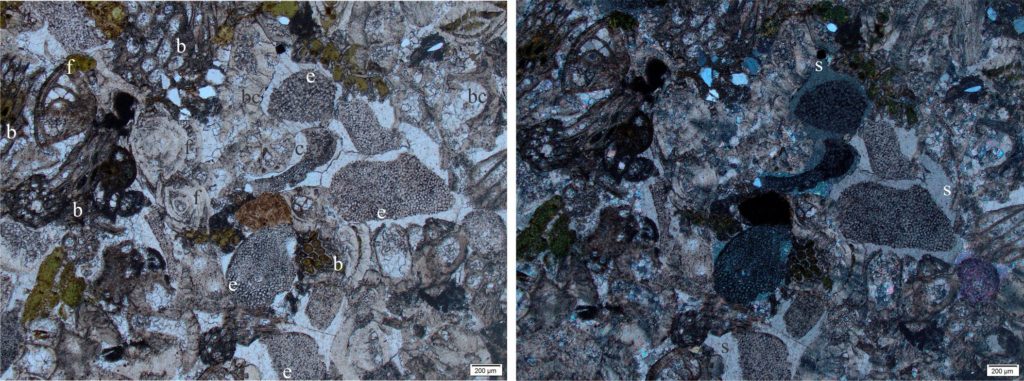

An Oligocene bioclastic, glauconitic limestone containing abundant abraded and broken echinoderm plates (e), most of which are encased in syntaxial calcite cement (s). Also present are numerous benthic forams (f), bryozoa fragments (b – some with glauconite filling), one small solitary coral (c – transverse section across septa), barnacle fragments with large pores filled by calcite cement (bc), and the occasional faecal pellet replaced by glauconite. Left: plain polarized light; Right: crossed polars. The syntaxial overgrowths extinguish at different stages for each echinoderm fragment.
Barnacles
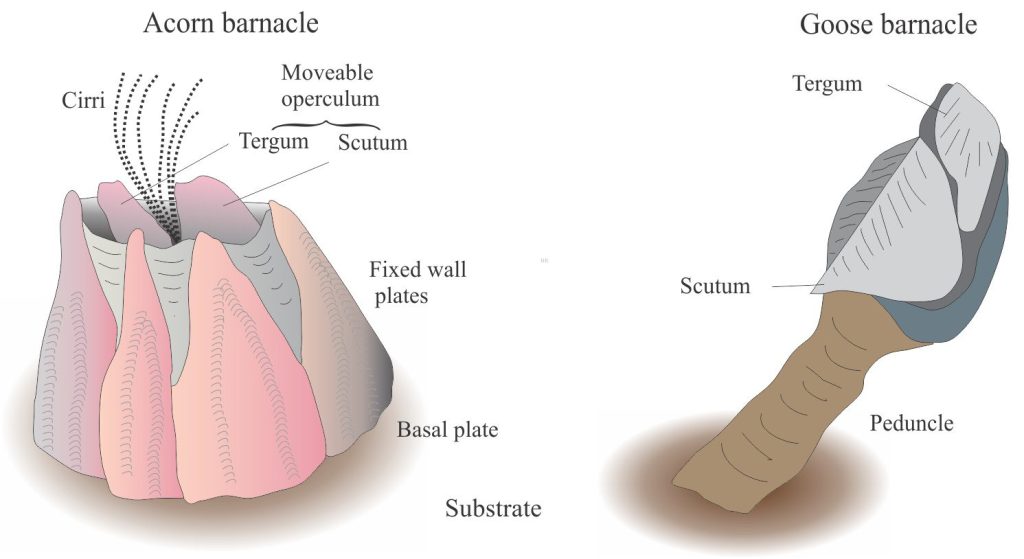

Sketches of the two barnacle morphologies based on common modern forms. Left is the acorn barnacle species Balanus with operculum intact, attached by a basal calcite plate; Right is the common Goose barnacle Lepas that attaches to substrates with a soft pedicle that allows the animal to move with waves and currents.
All barnacles live attached to hard substrates (rock, shells, wood). The majority of species reside in shallow, agitated water although a few have evolved to survive the darkness at bathyal depths (e.g., Bathylasma). One group, the goose barnacles, are attached by a long leathery tube (a peduncle) to rocks, floating logs, and other flotsam. However, the most familiar species (the acorn barnacles) attach themselves with a basal calcite plate to rocks, other shells, whales, and ship’s hulls.
A typical acorn barnacle consists of robust calcite and aragonite wall plates fitted to the margins of the basal plate. Wall plates are commonly plicated, or folded, presenting a ribbed appearance. The front door, or operculum, consists of two smaller triangular shaped calcium carbonate plates (the scutum and tergum) that open during feeding.
When the animal dies, the operculum disaggregates. The wall plates may be overgrown by a new generation of barnacles or dislodged by waves or moving sediment to become part of the bioclast sediment mass.


A recent temperate to subtropical NZ gastropod, Cookia sulcata, covered by the common acorn barnacle, Balanus. Most of the barnacles have lost their opercula.
Live goose barnacles (Lepas) attached to a log that was washed ashore during a storm, their cirri searching vainly for food. The calcite plates will join the local sediment mass when the animals die or are predated by marauding sea gulls. Raglan, northwest New Zealand.
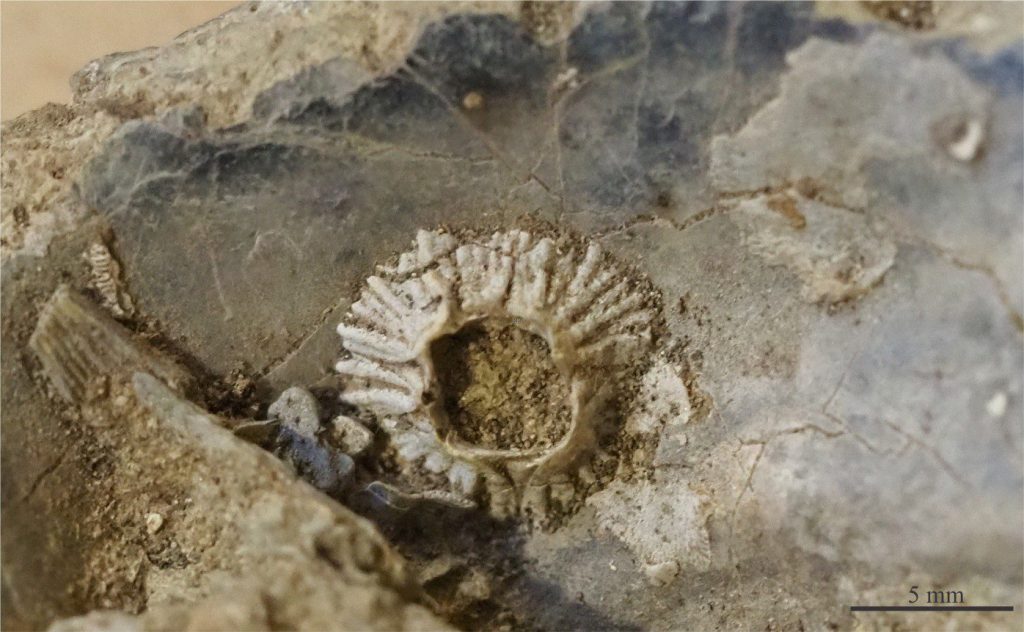

Apical view of a small, Pliocene acorn barnacle attached to a large oyster shell. The operculum and animal gut has been replaced by cemented carbonate sand. N.Z, Matemateaonga Formation.
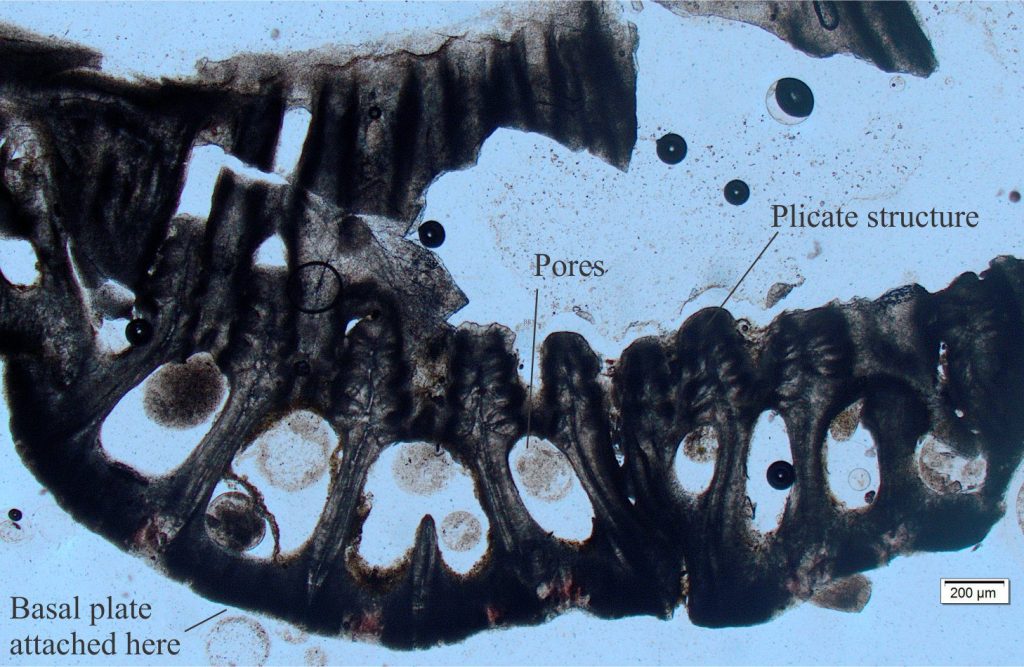

Thin section cut transverse to a recent acorn barnacle plate, showing the array or pores at the base of the plate. Note the finely layered calcite that extends upwards into the characteristic plications, or folds (see image below). Plain polarized light.
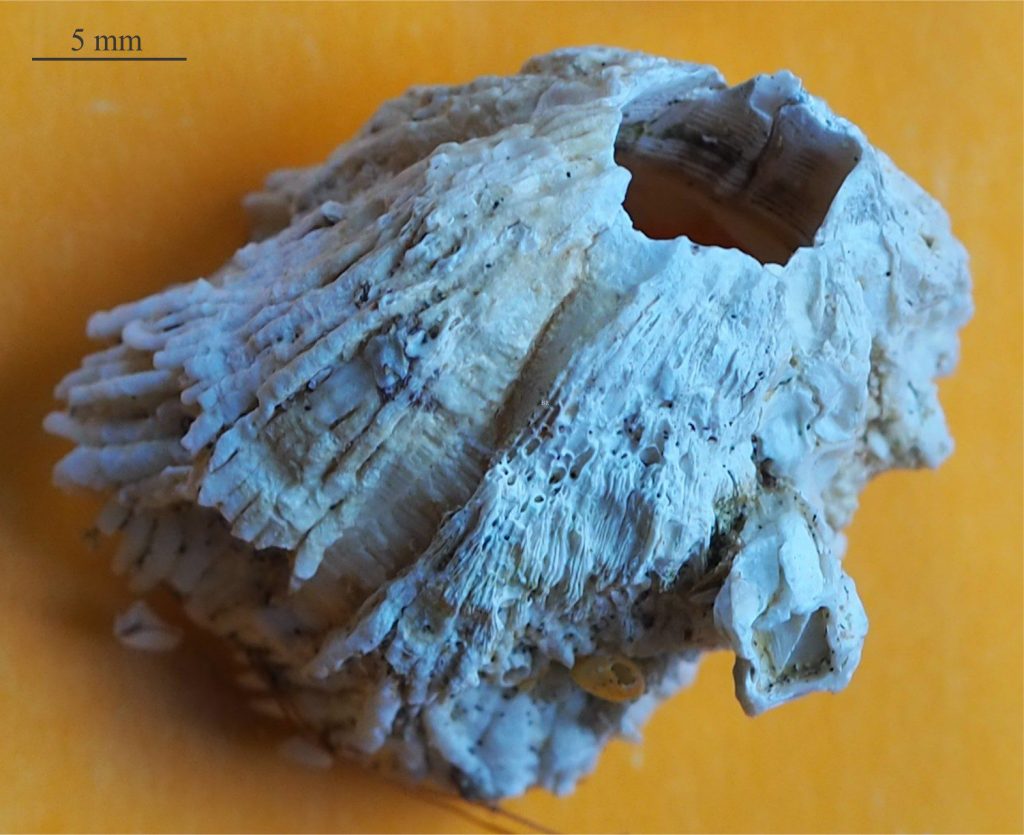

A modern Balanid barnacle. Note the rib-like plications (left side, and the longitudinal pores exposed on the abraded plate (centre). Specimen from Parengarenga, northernmost New Zealand


Thin section cut approximately parallel to a recent acorn barnacle plate, showing the characteristic plicate (folded) calcite structure. The left margin corresponds to the base of the plate (cf. the image above). Plain polarized light.


Fragments of Oligocene barnacle plates (centre and top left) showing typical plicate structure. The central fragment has a thin, outer marginal layer; the upper fragment has remnants of the large basal pores. The plates are surrounded by small dark brown pelloids. Crossed polars. Image courtesy of Cam Nelson.
Acknowledgement
Many thanks to Kirsty Vincent, Earth Sciences, Waikato University for access to the petrographic microscope.
Other posts in this series
Brachiopod morphology for sedimentologists
Bivalve shell morphology for sedimentologists
Gastropod shell morphology for sedimentologists
Cephalopod morphology for sedimentologists
Optical mineralogy: Some terminology
Carbonates in thin section: Molluscan bioclasts
Carbonates in thin section: Bryozoa
Carbonates in thin section: Forams and sponges
Neomorphic textures in thin section
Mineralogy of carbonates; skeletal grains
Bivalve morphology for sedimentologists
Mineralogy of carbonates; non-skeletal grains
Mineralogy of carbonates; lime mud
Mineralogy of carbonates; classification
Mineralogy of carbonates; carbonate factories
Mineralogy of carbonates; basic geochemistry
Mineralogy of carbonates; cements
Mineralogy of carbonates; sea floor diagenesis
Mineralogy of carbonates; Beachrock
Mineralogy of carbonates; deep sea diagenesis
Mineralogy of carbonates; meteoric hydrogeology
Mineralogy of carbonates; Karst
Mineralogy of carbonates; Burial diagenesis
Mineralogy of carbonates; Neomorphism
Mineralogy of carbonates; Pressure solution
Mineralogy of carbonates: Stromatolite reefs
